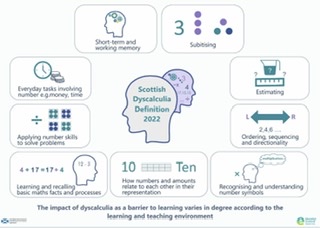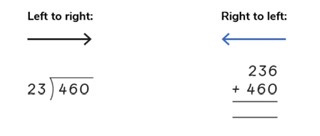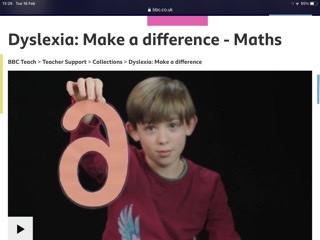
A cross party group have agreed on the Scottish working definition of Dyscalculia. The working definition is available on the Addressing Dyslexia Toolkit and the National Improvement Hub, see links below.
http://addressingdyslexia.org/what-dyscalculia
https://education.gov.scot/improvement/learning-resources/dyscalculia

Quick Tips for Supporting Dyslexic Learners with Maths
A common misconception about Dyslexia is that it just affects reading and writing but it can also affect maths too. Between 60 and 90 percent of children with dyslexia have challenges with certain aspects of maths. However, around 11% actually excel in maths.
Reading and Maths Vocabulary
-
Pre-teach mathematical vocabulary. Give visual support with maths words mat or list.
-
Teaching learners root words can support their understanding of mathematical vocabulary (i.e tri, meaning three, triangle)
-
Use the bar model to visualise word problems. This can help learners with dyslexia see what maths they have to do.
-
It is helpful to give every child with dyslexia their own textbook or own paper copy as it is less distracting than having to refer to the board.
-
Encourage learners jot down/draw thoughts and observations to support mental calculations through keeping a maths journal with information that helps their learning.
-
Keep vocabulary in word problems clear and unambiguous. Keep unnecessary information to a minimum reduces cognitive load. The Office lens app can read questions to learners from worksheets and textbooks.
-
Aperture cards can help learners keep track of which calculation they are working on.
Memory and Processing
-
Many learners with dyslexia have strong visual and spatial reasoning skills. They often, like many learners, better understand maths concepts that are taught through manipulative or visual teaching strategies. Cuisenaire Rods are a very versatile manipulative.
-
Playing cards, dice, and dominoes can be used for a whole variety of number games which reinforce the learning of visual number patterns.
-
When using CPA (Concrete, Pictorial, Abstract) approaches, it is important to remember that learners with dyslexia can benefit from spending longer on concrete and pictorial stages, or alongside, abstract representations.
-
Where possible, link maths to real life contexts that are practical and meaningful to the learner. This helps support memory retrieval.
-
Focus on conceptual understanding rather than procedure to help support learners with poor short-term and working memory.
-
Use ten frames with two- coloured counters and Cuisenaire rods to visualise number bonds.
-
Just as dyslexic learners need to learn how to break words apart they can also need support in breaking numbers apart.
-
Avoid any time pressure as it compromises working memory. Allow around 8 seconds of thinking time, which is longer than you think!
-
“Little and often approach”is useful where concepts and facts are revisited frequently.
-
Give learners number squares, timetable squares and number facts, teaching them how to use them. Teaching learners how to use the calculator is also useful. The Dyscalculator app helps learners understand numbers and choose the correct operation. They can also record their own voice saying the operations and numbers.
-
If a learner has orientation difficulties digits can be colour coded. Clockwise digits – 1,2,3,7. Anticlockwise digits – 0,4,5,6,8,9.
-
A learner with left/ right confusion may perform calculations in the wrong direction. This can be supported by drawing an arrow above with a colour for left and right, showing which direction to go in.

Maths Anxiety and Self Esteem
It is important to support learners with dyslexia and their self esteem. It can help if learners are encouraged to collaborate as it can take away pressure of working in isolation. Focus on the learner’s strengths and recognising what the pupil can do. Encourage a growth mindset as confidence and resilience play a huge part in a learner’s enjoyment and progress in maths. Pupils need to feel safe to explore and discover, take risks and learn through trial and error. Maths through stories, maths through art, breathing exercises, outdoor learning and games can help learners with maths anxiety.

Click the link below to listen to children describe how dyslexia impacts their maths.
https://www.bbc.co.uk/teach/teacher-support/dyslexia-make-a-difference-maths/zfr8qnb